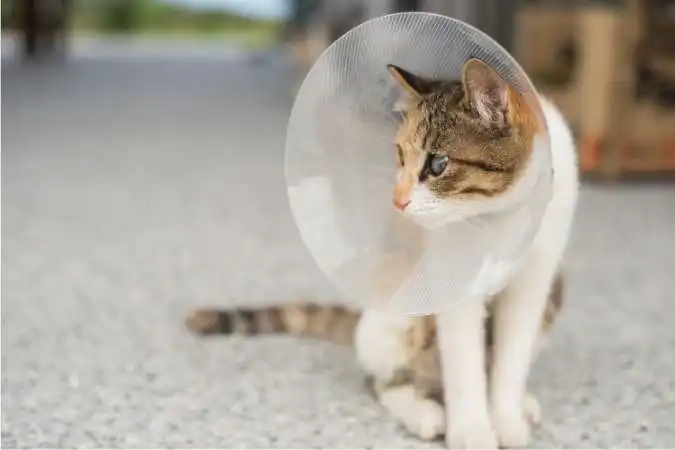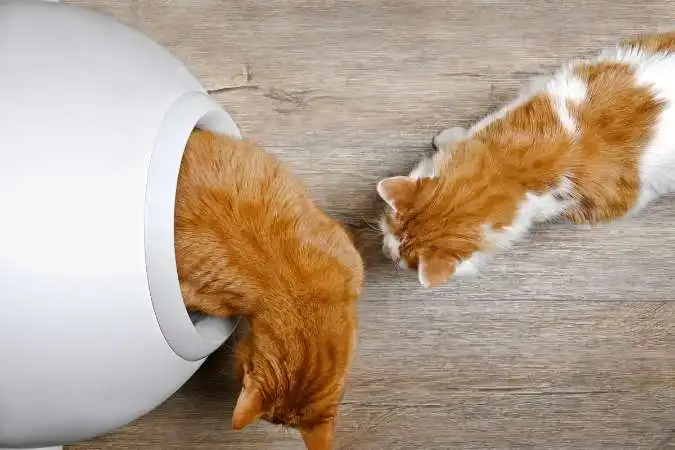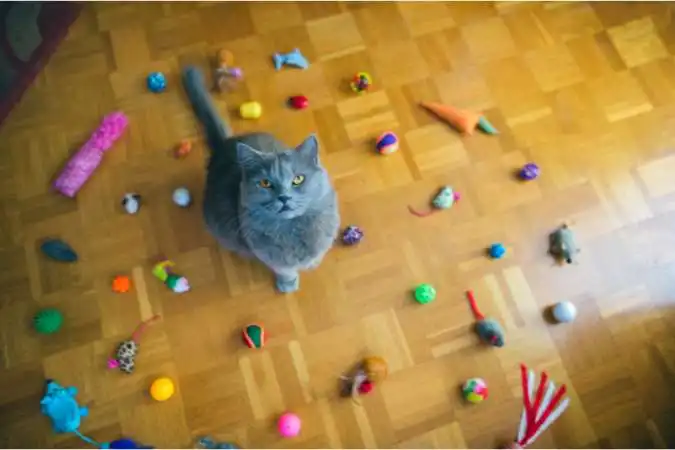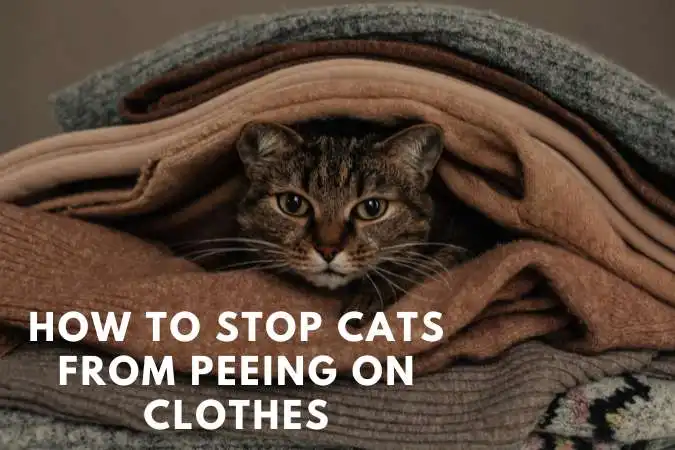Are you tired of finding your clothes drenched in cat pee? Or even when the urine stain has already set in the fabric? Of course, you are.
We understand that dealing with cat urine can be difficult, pushing many owners to the edge of almost giving up their cats to a shelter. But this does not have to happen; simply learn how to stop cats from peeing on clothes.
Additionally, you can train and encourage your cat to use the litter box all the time using the effective strategies we discuss in this article.
The ideal solution to the problem must come from an understanding of the root cause of why your cat is peeing inappropriately. Some of these causes include sickness, stress, or dirty litter boxes. It is always best to rule out infection before considering other probable causes.
If it is of any solace, you are not alone – as many as 25.4% of households in the US have kept a cat as a pet. Additionally, in 2018, it was estimated that there were about 370 million pet cats around the world. So, as you can imagine, many people go through similar situations of cats peeing on their clothes, sometimes repeatedly.
Learn How To Get Cat Urine Odor From Your Clothes
Determining And Understanding Why Cats Pee on Clothes

Cats are territorial animals – they will not always like to share the litter box, living, dining, or sleeping space with other cats. And it is not only the litter box and general area; they may get stressed, defensive, anxious, or even fight when they have to share their food and resources.
When cats need to communicate their displeasure or discomfort towards a specific stressful situation, they use their urine, which contains key messaging agents called pheromones. This is why inappropriate peeing in your cat should be interpreted as your cat’s frantic efforts to get your attention or send a message over a pressing need, – behavioral or medical.
Inappropriate elimination can stem from various reasons, such as:
- Dirty litter box
- Inappropriately-placed litter box
- Inadequate number of litter boxes
- Feeling threatened by other cats in the house or neighborhood
- Sickness
As mentioned earlier, the best starting point is to consult your veterinarian first to identify the root cause of your cat’s behavior. As a professional, a vet is best placed to perform a thorough physical examination and recommend the necessary tests to rule out any underlying medical conditions.
To learn more about why cat urine smell so bad here.
Step #1: Addressing Medical Issues
The number one thing to do is to eliminate the possibility of ailment causing inappropriate elimination. Some of the most common medical conditions that cause inappropriate elimination include:
- Urinary tract infections (UTIs)
- Bladder stones
- Kidney disease
- Diabetes
- Hyperthyroidism
Your veterinarian will prescribe the necessary medications if your cat is diagnosed with a medical condition.
Step #2: Deter Territorial Marking

Territorial marking, by its nature, suggests that your cat has a pet mate, whether a cat, a dog, or any other type of pet. Below are a few suggestions on how you can deter your cat from territorial marking:
- One of the best ways to deal with territorial marking is to teach your cat to be comfortable sharing space with other pets. Right from the age of kittenhood, teach your cat to be around other pets by introducing it to a wide variety of social scenarios and environments.
- If you’ve recently introduced a new pet into your household, stressing your cat, you should consider giving each pet (especially other cats) their space. Ensure the introduction is slow and progressive rather than taking a shock-and-awe approach.
A slow and steady introduction allows the cats to acclimate to each other. In the meantime, providing each cat with its own litter box, bed, feeding bowls, and water bowls/fountains will reduce conflict arising from resource competition.
Learn How To Get Cat Poop Odor From Your Clothes
Step #3: Get Your Cat Neutered Or Spayed

Related to deterring territorial marking, you can have your cat neutered or spayed. Neutered male cats and spayed female cats have less propensity for urine marking around.
As such, you can reduce the potential of your male cat peeing on clothes or anywhere else by neutering. One solution for a female cat peeing on clothes is to have it spayed. Aside from reducing the risk of urine marking, neutered cats are also less territorial, reducing the urge and need for spraying.
However, neutering and spaying are not the golden tickets to preventing inappropriate elimination by your cat. In fact, about 10% of neutered male cats and 5% of spayed female cats urine mark.
Step #4: Providing Adequate Litter Boxes

Cats are clean animals that prefer hygienic and pleasant litter boxes. If the litter box is dirty, the cat will not use it and may go on the clothes you forgot on the floor or couch.
Next time your cats pee on your clothes, consider that it could be that they are unhappy with sharing the litter box and consider investing in more. Otherwise, your clothes might smell like a giant litter box that has not been cleaned for a long time.
Here are some tips to ensure that your cat has a clean and pleasant litter box:
- Provide one litter box per cat, plus one extra. If you have multiple cats in your home, please be aware that they might only sometimes share the litter boxes. But you can make their coexistence more harmonious by providing one extra litter box above the number of furry friends in your home. For example, if you have ‘n’ cats, consider having n+1 litter boxes.
- Place litter boxes in quiet and accessible areas. As earlier mentioned, cats love their privacy, and placing their litter box in a high-traffic area jeopardizes that interest. Therefore, look for the right area in your home to put the litter boxes, provided it is safe, quiet, low-traffic, and easily accessible.
- Clean the litter box regularly. Keep the litter box clean by washing it regularly and using only appropriate cleaning products. You want to use unscented soap to break down the organic compounds in cat waste and neutralize nasty odors. Your cat will be more enticed to use the litter box when it smells fresh as often as possible.
- Use unscented and clumping litter. Indeed, different cats will prefer distinct types of cat litter, and you may have to try out various options before you find the right one. Many cats have shown a greater affinity for unscented and clumping litter.
- Try different litter boxes, such as covered ones that offer more privacy or uncovered ones for an open feeling, to see what your cat prefers. Note that a shy cat may be pessimistic about entering a covered litter box for fear of feeling cornered or caged. Also, does your cat love the color of the litter box? If it dislikes the color, it will hate going inside.
- Change your cat’s litter box and clean the box thoroughly. You may have to change the litter box regularly after the old one is old or highly laden with dirt and bacteria. Keeping the litter box clean also involves scooping as often as possible, preferably at least once daily.
You Might Be Interested In Learning How To Get Rid Of Cat Pee Out Of Your Bedsheets
Step #5: Environmental Enrichment

Stress and anxiety can lead to inappropriate elimination in cats, among other unwanted behaviors. On the other hand, environmental enrichment can help reduce stress levels and prevent your cat from peeing on clothes. Here are some ways to provide environmental enrichment:
- Provide scratching posts and playing toys to keep your cat engaged. Such tools keep the cat mentally stimulated and physically engaged and discourage urine marking or other attention-seeking behavior. Consider providing your cat with some regular time outside, too.
- Provide hiding spots, such as cardboard boxes or paper bags. Also, such spaces can be helpful when your cat feels anxious or threatened for various reasons, like when one of your guests suddenly comes to visit. Such a measure may benefit the more affectionate cats that need extra love and attention.
- Create vertical spaces such as cat trees or shelves. The vertical spaces give the cat a perching area, which feeds into its natural predatory hunting instincts. It uses these level areas to mark its territory and deter other cats from roaming in your compound. It is best if these raised climbing areas are placed near a window, where the cat can look at insects and get fascinated by other things outside.
- Use pheromone sprays or diffusers to create a calming environment. Feline pheromone products are designed to give off a smell considered “friendly” to your cat and are a calming aid. They increase your cat’s confidence and reduce stress. Thanks to the pheromones, the cat is less anxious and is less likely to have urine marks or scratches on surfaces.
- Set up a feeding schedule to establish a routine. Cats are usually at their best when on a routine – they are considered creatures of habit. A routine keeps them safe and confident. In some ways, you may need to incorporate some cat-related tasks into your daily schedule to maintain a stable routine for your cat.
- Eliminate stressors in your home. Examples of some everyday stressors are neighbors or cats roaming around your compound. The idea that your cat has to share its territory or food with other cats can be unsettling for the cat and lead it to lousy litter box behavior.
Step #6: Positive Reinforcement And Training

Another solution you should try when pondering how to stop cats from peeing on clothes is to train your cat appropriately. Positive reinforcement can encourage your cat to use the litter box and discourage inappropriate elimination.
However, it would help to begin by determining what your cat likes. For example, many cats like catnips or enjoy playing with their favorite toy.
The premise is that rewarding good behavior will encourage the cat to act even better. The reward or treatment for good behavior must not wait long after the cat has used the litter box properly – to create the maximum effect from this reward-based mechanism.
The reward must happen a few seconds after the act, preferably 3.
Here are some tips for positive reinforcement:
- Reward your cat with treats or praise when it uses the litter box. This can be combined with engaging the cat in interactive play, petting, or grooming.
- Use verbal cues such as “good job” or “good kitty” when your cat uses the litter box.
- Discourage inappropriate elimination by using deterrents such as double-sided tape or aluminum foil on the clothes. You can also consider preparing natural deterrents using lemon, citrus peels, essential oils, and water and spraying them on the areas you want to keep your cat from visiting.
Step #7: Deny Your Cat Access To Your Clothes

One of the best ways to stop cats from peeing in laundry baskets, clothes in your closet, or anywhere else is to deny them access. While this is an intuitive solution (after all if they cannot access the clothes, they cannot pee on them), it can be a challenge.
- You can start by closing the doors to your bedroom. If you can keep your laundry basket of dirty clothes in your bedroom, and your feline friend has been relieving himself or herself on your clothes, ensure you close the doors to your bedroom. The same goes for any other room that keeps dirty clothes, laundered clothes, or clothes in long-term storage. Just deny your cat the opportunity to create a mess.
- However, if you cannot or do not want to limit your cat’s access to rooms where your clothes are dirty or clean, consider denying your cat access to the clothes. Ensure that wherever you store your clothes, they are closed at all times. If you keep your clothes in a closet, keep the doors shut. If you keep your clothes in a suitcase, keep it closed. Buy a closable laundry basket to limit your cat’s access to dirty clothes.
- For long-term storage of your clothes, vacuum seal your clothes to limit your cat’s access to clothes you are not actively using. Importantly, store the clothes in parts of your house that your cat does not frequent.
Learn How To Stop Your Cat Peeing On The Bed
Additional Tips for Dealing with Cats Peeing on Clothes

- Use an enzymatic cleaner to clean clothes and all of the surfaces soiled by cats. An enzymatic cleaner is preferred to remove cat urine odor from your clothes as it eliminates everything and does not cover up the stain and the odor for some time. You must remove all the odor instead of simply masking the urine stain, as the lingering urine smell can attract the cat to pee on your clothing again. Unless you can eliminate the odor, the cat can still smell it long after cleaning, and we humans cannot.
- Provide enough water bowls for your cat to stay hydrated, prevent the formation of bladder stones and crystals, and improve kidney health. Ensure you change the drinking water at least once daily to stop the prevalence of bacteria. Alternatively, you can use water fountains to provide the water, as cats like running water, and can encourage the cat to stay hydrated as much as possible.
- Keep your cat’s litter boxes away from food and water bowls. Cats are pretty hygienic and prefer a separate eating and bathroom area.
- Address conflicts between cats in multi-cat households. Provide enough food and water bowls, litter boxes, and sleeping areas for all your cats. Ensure each cat has access to sufficient resources to minimize conflict between the cats and prevent stress and conflict between cats.
- Seek help from a professional animal behaviorist if the problem persists. The experienced vet may recommend spaying or neutering to stop the cat from urine marking. Neutering can be especially helpful for male cats (than spaying for females) since the former have higher testosterone levels and, therefore, more frequent urine marking tendencies.
Conclusion: How To Stop Cats From Peeing On Clothes
Inappropriate elimination can be a frustrating problem for cat owners. However, understanding the reasons behind your cat’s behavior and taking the necessary steps to address it can prevent it from peeing on your clothes.
Remember that seeking advice from a veterinarian or animal behaviorist can also be beneficial in dealing with this problem.
You can stop your cat from peeing on clothes by providing adequate litter boxes, environmental enrichment, positive reinforcement, and addressing medical issues. You can enjoy a clean and stress-free home with your furry friend with patience, persistence, and the right approach.
We hope these tips and tricks help you in your efforts to stop your cat from peeing on clothes. Do you have any other tips or experiences to share? Let us know in the comments below!
FAQs
Q: Why is my cat peeing on my clothes?
A: There could be several reasons why your cat is peeing on your clothes, including medical issues, litter box aversion, territorial marking, and stress. Addressing these underlying causes can help stop the behavior.
Q: What should I do if my cat starts peeing on my clothes suddenly?
A: Sudden changes in your cat’s behavior could indicate a medical problem or stressor. Take your cat to the veterinarian to rule out any medical issues and address any changes in your cat’s environment that could be causing stress.
Q: How many litter boxes should I have for my cat?
A: The general rule of thumb is to have one litter box per cat, plus one extra. So, if you have one cat, you should have two litter boxes, and if you have two cats, you should have three litter boxes.
Q: Should I punish my cat for peeing on my clothes?
A: No, punishment is not an effective way to stop inappropriate elimination and can make the behavior worse. Instead, focus on addressing the underlying causes of the behavior and providing positive reinforcement for good litter box habits.
Q: Can male cats be more prone to peeing on clothes than females? A: Yes, male cats are more likely to engage in territorial marking behavior, which can include peeing on clothes. However, female cats can also exhibit this behavior.

